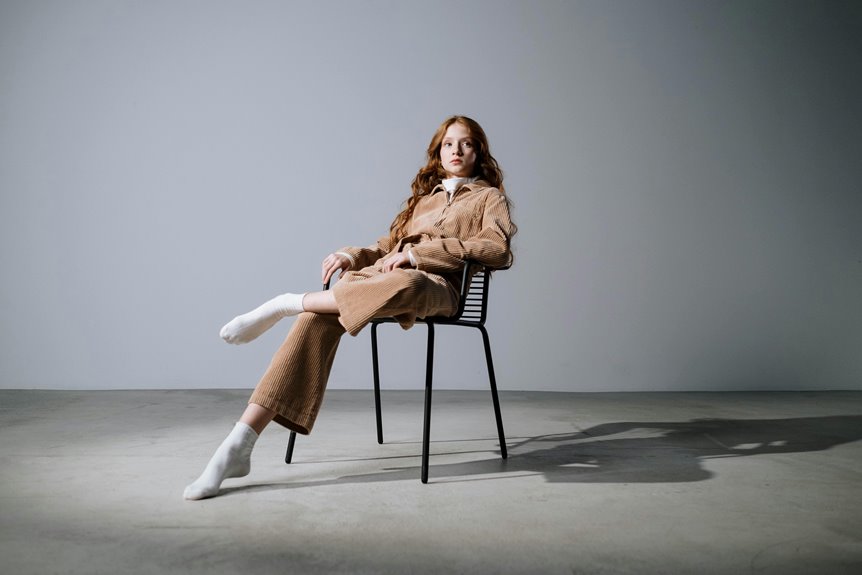Corduroy’s unique texture comes from its raised ridges called wales, woven to create a soft yet durable fabric that keeps you warm. Originally popular workwear in Europe, it’s now a stylish choice with various types like fine or wide wale. To keep your corduroy looking great, wash it gently inside out and avoid harsh chemicals. Whether you want to add classic pants or a jacket to your wardrobe, understanding these basics will help you appreciate corduroy’s lasting appeal and versatility.
Key Takeaways
- Corduroy is a durable fabric defined by raised parallel ridges called wales, created by weaving extra filling yarns for texture and warmth.
- It originated from medieval European fustian fabric and gained popularity in 18th-century England and France as practical workwear.
- Corduroy comes in fine, mid, and wide wale varieties, offering different textures and styles from polished to rugged casual.
- Proper care includes washing inside out on gentle cycles with cold water, avoiding bleach, and air drying or tumble drying low.
- Styling tips include pairing corduroy with denim or knits, choosing neutral tones for versatility, and layering with sweaters or jackets.
The History and Origins of Corduroy
Although corduroy feels timeless today, its origins date back centuries to ancient textile traditions. You’ll find that corduroy evolved from fustian, a woven fabric popular in medieval Europe.
Originally, artisans created a durable cloth with raised ridges by weaving extra sets of threads, giving the fabric its distinctive texture. By the 18th century, corduroy became especially favored in England and France for workwear because of its strength and warmth.
The name “corduroy” likely combines “cord” for the fabric’s ribbed pattern and “duroy,” a coarse woolen cloth once made in England. As you explore its past, you’ll see how corduroy shifted from practical origins to a fashionable fabric embraced worldwide, reflecting a blend of craftsmanship and cultural shifts over time.
Characteristics That Define Corduroy Fabric
Corduroy’s unique appeal lies in its distinct texture and construction, which set it apart from other fabrics. When you touch corduroy, you feel raised ridges called “wales” running parallel along the fabric. These wales vary in width, influencing the fabric’s look and feel.
The fabric is woven with extra sets of filling yarns, creating its signature ribbed pattern. You’ll notice corduroy’s durability and softness, making it comfortable and long-lasting. Its pile surface also gives it a slight sheen, adding visual depth.
Additionally, corduroy tends to retain warmth better than many fabrics, which is why it’s popular in cooler seasons. By understanding these defining features, you can better appreciate why corduroy remains a classic choice in fashion and upholstery.
Different Types and Styles of Corduroy
Variety defines corduroy, offering you several types and styles to choose from based on wale width, fabric weight, and finish.
You’ll find fine-wale corduroy with narrow ridges, perfect for a polished look, while wide-wale corduroy boasts thicker ridges, giving a rugged, casual vibe. Mid-wale strikes a balance, making it versatile for different occasions.
When it comes to weight, lightweight corduroy suits warmer weather, whereas heavyweight options provide warmth and durability for colder months.
Finishes can range from smooth and velvety to more textured, affecting both appearance and feel.
Whether you prefer classic straight wales or trendy pinwale styles, corduroy adapts to your style needs, making it a timeless fabric choice for various garments.
How to Care for and Maintain Corduroy Clothing
Taking proper care of your corduroy clothing guarantees it stays soft, vibrant, and durable over time.
Always turn your garments inside out before washing to protect the fabric’s texture. Use cold water and a gentle cycle to prevent shrinking and fading. Avoid bleach, which can damage the fibers.
When drying, skip the high heat—air drying or tumble drying on low keeps the fabric intact. To maintain the corduroy’s signature ribs, brush gently with a soft clothes brush after washing.
If wrinkles appear, steam rather than iron directly to avoid crushing the pile. Store corduroy items on hangers or folded carefully to prevent creasing.
Following these steps helps your corduroy look its best and extend its lifespan without compromising comfort or style.
Styling Tips: Incorporating Corduroy Into Your Wardrobe
Looking to add texture and warmth to your outfits? Corduroy is perfect for that.
Start with classic corduroy pants in neutral tones like beige, brown, or navy—they pair well with simple tees or crisp button-downs. For a casual vibe, layer a corduroy jacket over a sweater or hoodie.
Don’t shy away from mixing textures; corduroy complements denim, leather, and knits beautifully. If you’re feeling bold, try corduroy skirts or dresses in rich autumnal colors.
Keep accessories minimal to let the fabric shine. Remember, fit matters—opt for tailored pieces to avoid looking bulky.
Frequently Asked Questions
Is Corduroy Fabric Environmentally Friendly?
You might find corduroy’s environmental impact varies based on its material. If it’s made from organic cotton or recycled fibers, it’s more eco-friendly. Conventional cotton corduroy, however, can involve intensive water and pesticide use.
Can Corduroy Be Used for Upholstery?
You might not expect corduroy’s soft texture to withstand heavy use, but it actually works well for upholstery. Its durability and distinctive ridges add both comfort and style to your furniture, making it a smart choice.
How Does Corduroy Compare to Velvet?
You’ll find corduroy more durable and textured, perfect for casual wear, while velvet feels smoother and luxe, ideal for formal pieces. Both offer warmth, but velvet’s shine gives it a richer, elegant vibe compared to corduroy.
Are There Seasonal Variations in Corduroy’S Popularity?
You’d think corduroy’s popularity explodes like fireworks every fall! It’s definitely a cold-weather favorite, cozy and warm, but in summer, it quietly hides away, waiting for cooler days to shine again in your wardrobe.
What Is the Best Way to Remove Stains From Corduroy?
You should gently blot the stain with cold water and mild detergent, then let it air dry. Avoid rubbing, as it can damage the fabric. For tough stains, try a fabric-safe stain remover before washing.

